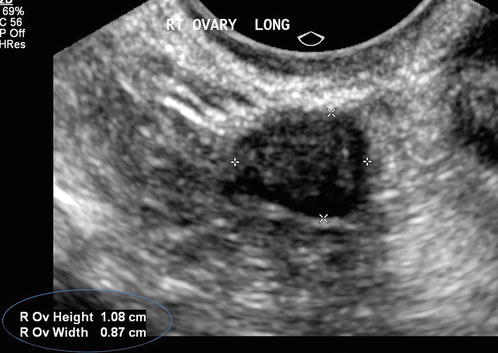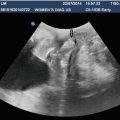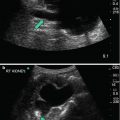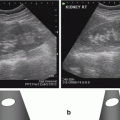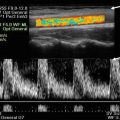Fig 7.1
Transabdominal imaging of pelvic organs
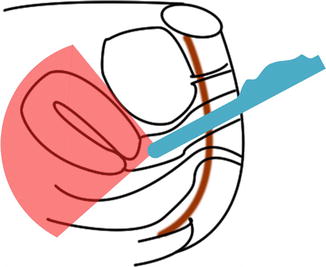
Fig 7.2
Transvaginal imaging of pelvic organs
Technique of Transabdominal Imaging of the Pelvic Organs (Video 7.1)
Transabdominal ultrasound of the pelvic organs is generally performed with a full bladder. This allows for an overview of the entire pelvis (Fig. 7.1). A large pelvic mass may only be seen transabdominally and can be missed if only a transvaginal ultrasound is performed.
Begin by scanning just above the pubic symphysis in the sagittal plane. Use the bladder as an acoustic window to the pelvis. Angle the transducer into the pelvis and identify the uterus (Fig. 7.3). Assess whether the uterus is anteverted or retroverted. Look for any uterine masses by sweeping the transducer from one side to the other. Rotate the transducer 90° to assess the uterus in the transverse plane. Sweep the transducer up and down the uterus.
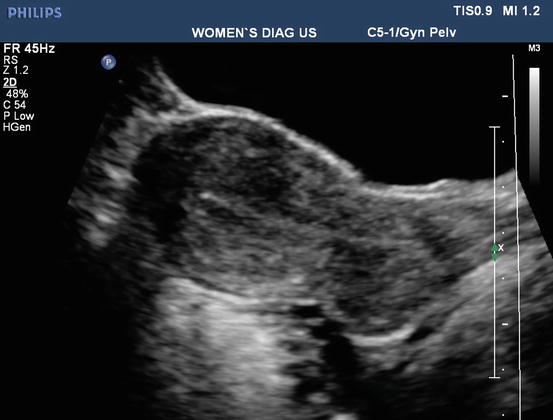
Fig 7.3
Transabdominal image of the uterus in the mid-sagittal plane
The endometrium should be assessed in the sagittal plane from the endocervical canal to the fundus. Rotate the transducer and assess the endometrium in the transverse plane.
Following assessment of the endometrium, angle the transducer laterally towards the adnexae to assess the ovaries. The ovaries are hypoechoic ovoid structures which are generally located between the uterus and the iliac vessels (Fig. 7.4). Examine the ovary in two planes and then assess the other ovary. Assess the adnexal regions and Pouch of Douglas.
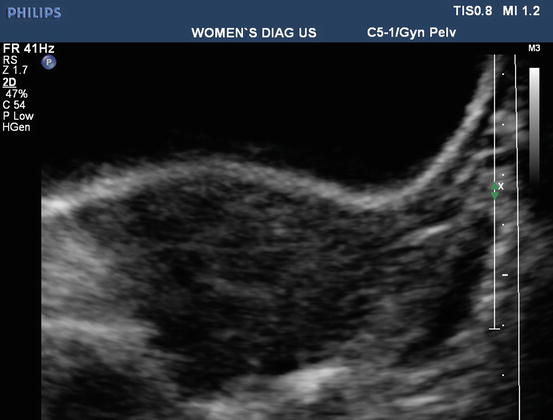
Fig 7.4
Transabdominal image of left adnexa showing the uterus and the left ovary
Transvaginal Assessment of Female Pelvic Organs (Video 7.2)
Transvaginal ultrasound scan is performed with an endocavity transducer. The patient should be asked to empty her bladder prior to the ultrasound scan.
Begin by inserting the transducer in the sagittal plane to identify the uterus. To find the uterus, the transducer may need to be swept slightly to the left or right of the mid-sagittal plane or directed anteriorly or posteriorly.
Once the uterus is identified, rotate the transducer so that a true mid-sagittal view of the uterus is obtained (Fig. 7.5). In the mid sagittal plane the endometrium should be seen from the cervix up to the fundus (calipers).
Assess the uterus by sweeping from one side to the other in the sagittal plane and then cranially and caudally in the transverse plane to examine the whole uterus.
The endometrium should be assessed in the sagittal plane from the endocervical canal to the fundus. Rotate the transducer and assess the endometrium in the transverse plane.
Then look for the ovaries in the transverse plane by withdrawing the transducer out slightly and angling towards to the left or right fornix of the vagina. Sweep cranially and caudally to find the ovary. Assess the ovary in two planes then assess the other ovary.
Look at the surrounding structures between the uterus and ovaries for any other adnexal masses.
Return to the midline and angle the transducer posteriorly to assess for free fluid in the Pouch of Douglas.
At the end of the examination, assess the vagina during withdrawal of the transducer from the vagina. Gartner’s duct cysts are often only seen as the transducer is being removed.
The Normal Female Pelvis
In order to recognize pelvic pathology, it is important to be familiar with the anatomy of the normal pelvis. The following are images of the normal pelvis.
Figure 7.5 shows an anteverted uterus, where the fundus of the uterus is directed towards the bladder. The majority of women have an anteverted uterus. In this image the endometrial stripe is seen in the proliferative phase (first half of the menstrual cycle) as a triple layer appearance. The uterus is usually 6–10 cm in length when measured from the cervix to the fundus in a menstruating woman.


Fig. 7.5
Transvaginal image of an anteverted normal uterus in the mid sagittal plane
There is a Nabothian follicle in the cervix (blue arrow). These are commonly seen and is a normal finding. Figure 7.6 shows a retroverted uterus, where the fundus of the uterus is directed away from the bladder. In this image the uterus is in the secretory phase of the menstrual cycle. The endometrium has lost the triple layer appearance and is thick and echogenic (blue arrow).
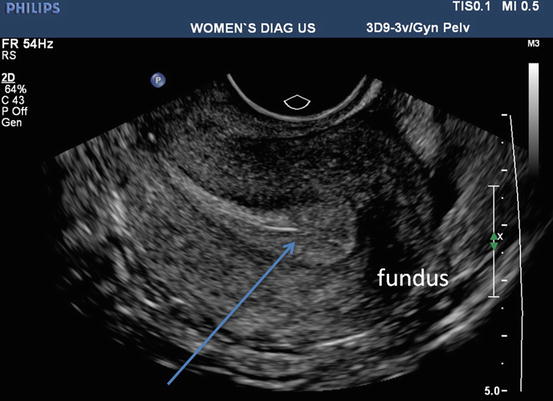

Fig 7.6
Transvaginal image of a retroverted normal uterus in the mid sagittal plane
Figure 7.7 is of an anteverted uterus in the menstrual phase of the cycle. The endometrial echo is seen as a thin, regular echogenic stripe (blue arrow).
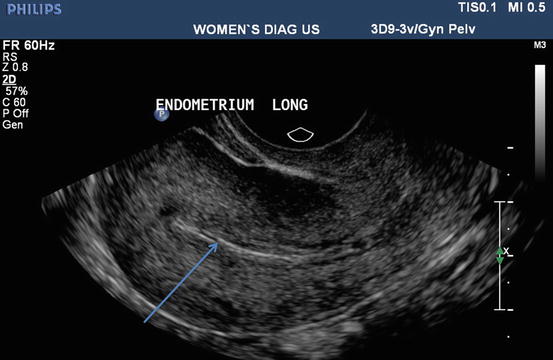

Fig. 7.7
Transvaginal image of a normal uterus in the menstrual phase of the cycle
The postmenopausal uterus is small and should be 4–6 cm in length, with a thin endometrial stripe. The endometrium should measure <4 mm in thickness (Fig. 7.8).
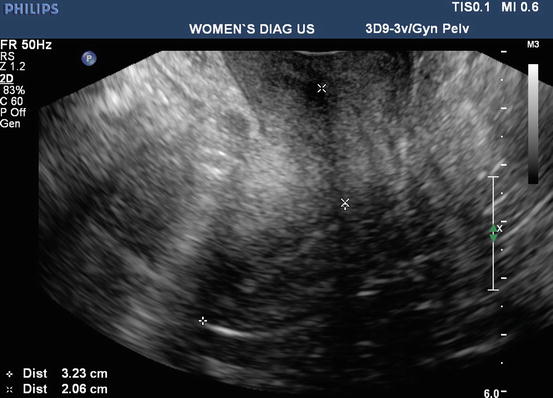

Fig. 7.8
Transvaginal image of a normal postmenopausal uterus
In this image of a normal ovary (Fig. 7.9) it can be seen as an oval hypoechoic structure. A few follicles can be identified – red arrows (usually about 6). There is a dominant follicle which measures 15.4 mm in diameter (calipers).
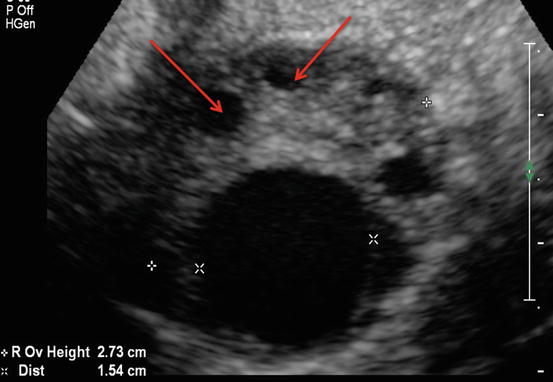

Fig. 7.9
Transvaginal image of a normal ovary in a woman of reproductive age
The normal ovary is usually about 4 × 3 × 2 cm in size in a woman of reproductive age. The ovary is usually found lateral to the uterus on each side, lying between the uterus and the iliac vessels. Occasionally the ovary is in the Pouch of Douglas or superior to the uterus.
Figure 7.10 is an image from a postmenopausal woman where the ovary is small and has little or no follicular activity.
